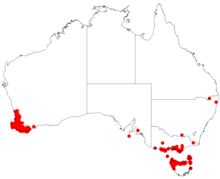| Leucopogon australis | |
|---|---|

| |
| Near Bicheno | |
| Scientific classification | |
| Kingdom: | Plantae |
| Clade: | Tracheophytes |
| Clade: | Angiosperms |
| Clade: | Eudicots |
| Clade: | Asterids |
| Order: | Ericales |
| Family: | Ericaceae |
| Genus: | Leucopogon |
| Species: | L. australis |
| Binomial name | |
| Leucopogon australis R.Br. | |

| |
| Occurrence data from AVH | |
| Synonyms | |
| |
Leucopogon australis, commonly known as spiked beard-heath, is a species of flowering plant in the heath family Ericaceae and is endemic to southern Australia. It is an erect, aromatic shrub with narrowly egg-shaped to narrowly elliptic leaves, and white flowers arranged in spikes near the ends of branchlets.
Description
Leucopogon australis is an erect, aromatic shrub that typically grows to a height of 1–2 m (3 ft 3 in – 6 ft 7 in) and has glabrous branchlets. The leaves are more or less glabrous, narrowly egg-shaped to narrowly elliptic, 10–85 mm (0.39–3.35 in) long and 2–10 mm (0.079–0.394 in) wide on a petiole 0.6–1.5 mm (0.024–0.059 in) long. The flowers are arranged in groups of 8 to 28 and 8–34 mm (0.31–1.34 in) long on the ends of branchlets, or in upper leaf axils, with egg-shaped bracts 0.7–1 mm (0.028–0.039 in) long and similar bracteoles. The sepals are egg-shaped, 1.2–1.9 mm (0.047–0.075 in) long and yellowish. The petals are joined at the base to form a bell-shaped tube about as long as the sepals, the lobes white and 2.3–2.7 mm (0.091–0.106 in) long and densely bearded on the inside. Flowering occurs from September to November and the fruit is a flattened spherical drupe 1.8–2.2 mm (0.071–0.087 in) long.
Taxonomy and naming
Leucopogon australis was first formally described in 1810 by Robert Brown in his Prodromus Florae Novae Hollandiae. The specific epithet (australis) means "southern".
Distribution and habitat
This leucopogon grows in the understorey of forest in wetter places within 100 km (62 mi) of the coast of Western Australia between Gingin, Augusta and Albany, Peterborough and Yarram in Victoria, and northern Tasmania, where it is rare.
References
- ^ "Leucopogon australis". Australian Plant Census. Retrieved 15 May 2022.
- ^ "Leucopogon australis". FloraBase. Western Australian Government Department of Biodiversity, Conservation and Attractions.
- ^ Hislop, Michael C. (2008). "Three new species of Leucopogon (Ericaceae: Styphelioideae: Styphelieae) from the far south-west of Western Australia" (PDF). Nuytsia. 18: 67–69. Retrieved 15 May 2022.
- ^ Powell, Jocelyn M.; Walsh, Neville G.; Brown, Elizabeth A. "Leucopogon australis". Royal Botanic Gardens Victoria. Retrieved 15 May 2022.
- "Leucopogon australis". APNI. Retrieved 15 May 2022.
- Brown, Robert (1810). Prodromus Florae Novae Hollandiae. London. p. 541. Retrieved 15 May 2022.
- Sharr, Francis Aubi; George, Alex (2019). Western Australian Plant Names and Their Meanings (3rd ed.). Kardinya, WA: Four Gables Press. p. 141. ISBN 9780958034180.
- Jordan, Greg. "Leucopogon australia". University of Tasmania. Retrieved 16 May 2022.
| Taxon identifiers | |
|---|---|
| Leucopogon australis | |